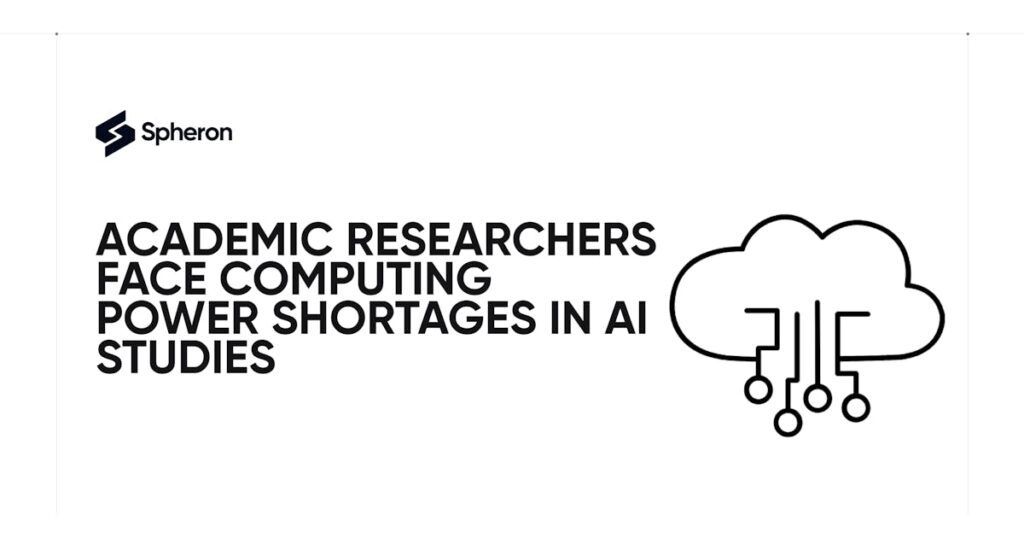A recent survey highlights the frustration among university scientists over limited access to computing power for artificial intelligence (AI) research. The findings, shared on the arXiv on October 30, reveal that academics often lack the advanced computing systems required to work on large language models (LLMs) and other AI projects effectively.
One of the primary challenges for academic researchers is the shortage of powerful graphics processing units (GPUs)—essential tools for training AI models. These GPUs, which can cost thousands of dollars, are more accessible to researchers in large technology companies due to their larger budgets.
The Growing Divide Between Academia and Industry
Defining Academic Hardware
In the context of AI research, academic hardware generally refers to the computational tools and resources available to researchers within universities or public institutions. This hardware typically includes GPUs (Graphics Processing Units), clusters, and servers, which are essential for tasks like model training, fine-tuning, and inference. Unlike industry settings, where cutting-edge GPUs like NVIDIA H100s dominate, academia often relies on older or mid-tier GPUs such as RTX 3090s or A6000s.
Commonly Available Resources: GPUs and Configurations
Academic researchers typically have access to 1–8 GPUs for limited durations, ranging from hours to a few weeks. The study categorized GPUs into three tiers:
-
Desktop GPUs – Affordable but less powerful, used for small-scale experiments.
-
Workstation GPUs – Mid-tier devices with moderate capabilities.
-
Data Center GPUs – High-end GPUs like NVIDIA A100 or H100, ideal for large-scale training but often scarce in academia.
Khandelwal and his team surveyed 50 scientists from 35 institutions to assess the availability of computing resources. The results were striking: 66% of respondents rated their satisfaction with computing power as 3 or less out of 5. “They’re not satisfied at all,” says Khandelwal.
Universities manage GPU access differently. Some offer centralized compute clusters shared across departments, where researchers must request GPU time. Others provide individual machines for lab members.
For many, waiting for GPU access can take days, with delays becoming especially acute near project deadlines. Researchers also reported notable global disparities. For instance, a respondent from the Middle East highlighted significant challenges in obtaining GPUs. Only 10% of those surveyed had access to NVIDIA’s H100 GPUs—state-of-the-art chips tailored for AI research.
This shortage particularly affects the pre-training phase, where LLMs process vast datasets. “It’s so expensive that most academics don’t even consider doing science on pre-training,” Khandelwal notes.
Key Findings: GPU Availability and Usage Patterns
-
GPU Ownership vs. Cloud Use: 85% of respondents had zero budgets for cloud compute (e.g., AWS or Google Cloud), relying instead on on-premises clusters.Hardware owned by institutions was deemed more cost-effective in the long run, though less flexible than cloud-based solutions.
-
Usage Trends: Most respondents used GPUs for fine-tuning models, inference, and small-scale training. Only 17% attempted pre-training for models exceeding 1 billion parameters due to resource constraints.
-
Satisfaction Levels: Two-thirds rated their satisfaction with current resources at 3/5 or below, citing bottlenecks such as long wait times and inadequate hardware for large-scale experiments.
Limitations and Challenges Identified
-
Regional Disparities: Researchers in regions like the Middle East reported limited access to GPUs compared to counterparts in Europe or North America.
-
Institutional Variances: Liberal arts colleges often lacked compute clusters entirely, while major research universities occasionally boasted tens of thousands of GPUs under national initiatives.
Pre-training Feasibility for Academic Labs
Pre-training large models such as Pythia-1B (1 billion parameters) often requires significant resources. Originally trained on 64 GPUs in 3 days, academic researchers demonstrated the feasibility of replicating this model on 4 A100 GPUs in 18 days by leveraging optimized configurations.
The benchmarking revealed:
-
Training time was reduced by 3x using memory-saving and efficiency strategies.
-
Larger GPUs, like H100s, cut training times by up to 50%, though their higher cost makes them less accessible to most institutions.
Efficiency techniques, such as activation checkpointing and mixed-precision training, enabled researchers to achieve outcomes similar to those of industry setups at a fraction of the cost. By carefully balancing hardware usage and optimization strategies, it became possible to train models like RoBERTa or Vision Transformers (ViT) even on smaller academic setups.
Cost-Benefit Analysis in AI Training
A breakdown of hardware costs reveals the trade-offs academic researchers face:
-
RTX 3090s: $1,300 per unit; slower training but budget-friendly.
-
A6000s: $4,800 per unit; mid-tier performance with better memory.
-
H100s: $30,000 per unit; cutting-edge performance at a steep price.
Training Efficiency vs. Hardware Costs
For example, replicating Pythia-1B on:
-
8 RTX 3090s costs $10,400 and takes 30 days.
-
4 A100s costs $76,000 and takes 18 days.
-
4 H100s costs $120,000 and are completed in just 8 days.
Case Studies: RTX 3090s vs. H100 GPUs
While H100s provide unparalleled speed, their cost makes them unattainable for most academic labs. Conversely, combining memory-saving methods with affordable GPUs like RTX 3090s offers a slower but feasible alternative for researchers on tight budgets.
Optimizing Training Speed on Limited Resources
Free-Lunch Optimizations
Techniques like FlashAttention and TF32 mode significantly boosted throughput without requiring additional resources. These “free” improvements sometimes reduced training times by up to 40%.
Memory-Saving Methods: Advantages and Trade-offs
Activation checkpointing and model sharding reduced memory usage, enabling larger batch sizes. However, these techniques sometimes slowed training due to increased computational overhead.
Combining Strategies for Optimal Outcomes
By combining free-lunch and memory-saving optimizations, researchers achieved up to 4.7x speedups in training time compared to naive settings. Such strategies are essential for academic groups looking to maximize output on limited hardware.

